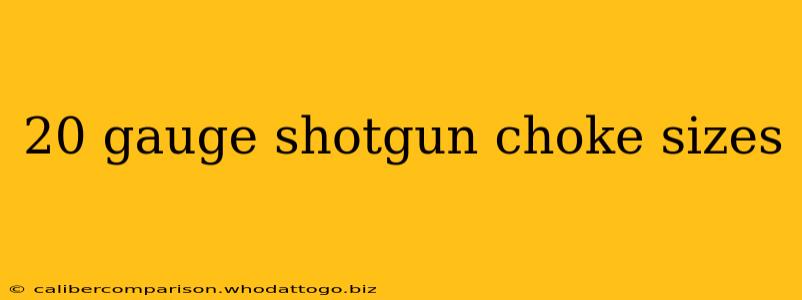Choosing the right choke for your 20 gauge shotgun can significantly impact your shooting performance. Understanding the different choke sizes and their applications is crucial for achieving consistent accuracy and maximizing your hunting or sporting success. This guide delves into the specifics of 20 gauge choke tubes, helping you select the perfect fit for your needs.
Understanding Choke Tubes and Their Function
Before diving into specific 20 gauge choke sizes, let's clarify the fundamental role of choke tubes. A choke tube is a cylindrical device inserted into the muzzle of a shotgun barrel. It constricts the diameter of the barrel, influencing the shot pattern. This constriction affects the spread of the shot pellets, impacting the shot's range and density.
Common 20 Gauge Choke Sizes and Their Applications
The constriction of a choke tube is measured in terms of its diameter and is usually expressed as a fraction of an inch. While slight variations exist among manufacturers, here's a breakdown of common 20 gauge choke sizes and their typical applications:
1. Cylinder Bore (CYL)
- Constriction: Minimal to no constriction.
- Shot Pattern: Wide, open pattern ideal for very close-range shooting (e.g., under 25 yards).
- Applications: Best suited for upland bird hunting at extremely close ranges or informal target shooting where a wide pattern is desired. Generally not ideal for long-range shooting.
2. Improved Cylinder (IC)
- Constriction: Slightly more constriction than Cylinder Bore.
- Shot Pattern: Moderately open pattern, offering a balance between range and pattern density.
- Applications: Versatile choke suitable for various hunting scenarios, including closer-range upland bird hunting and some trap shooting.
3. Modified (MOD)
- Constriction: Moderate constriction, offering a tighter pattern than IC.
- Shot Pattern: A good balance between range and pattern density, offering a tighter group of pellets.
- Applications: A popular all-around choice for hunting a variety of game, including waterfowl at moderate ranges and upland birds at greater distances. Also suitable for some sporting clays.
4. Improved Modified (IMOD)
- Constriction: Tighter than Modified, offering a more focused pattern.
- Shot Pattern: A relatively tight pattern with good range and accuracy.
- Applications: Ideal for hunting waterfowl at longer ranges or for situations requiring precise shot placement. Suitable for some sporting clays events.
5. Full (FULL)
- Constriction: The tightest constriction, producing a very concentrated shot pattern.
- Shot Pattern: Extremely tight pattern suitable for long-range shooting, but with a reduced effective range due to pellet density.
- Applications: Best for long-range waterfowl hunting where a focused pattern is crucial. Generally not recommended for close-range shooting or hunting smaller, faster targets.
Choosing the Right Choke for Your 20 Gauge Shotgun
Selecting the appropriate choke depends heavily on the type of game you're hunting, the distance to the target, and your personal shooting style. Consider these factors:
- Target Distance: Closer ranges require more open chokes (Cylinder Bore, IC), while longer ranges benefit from tighter chokes (Modified, Improved Modified, Full).
- Game Type: Smaller, faster-moving targets (e.g., doves, quail) typically require less constriction. Larger, slower-moving targets (e.g., geese, ducks) often require tighter constriction.
- Ammunition: The type of ammunition used can also influence the effectiveness of different chokes.
Experimentation is key to finding the optimal choke for your specific needs and preferences. Start with a general-purpose choke like Modified and adjust from there based on your shooting experience and results. Remember safety is paramount; always practice responsible gun handling and adhere to all relevant safety regulations.

